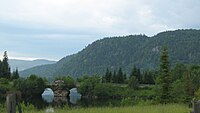
Photo from wikipedia
Mountain lakes provide some fundamental ecosystem services (i.e., water supply for drinking and energy production) and have an enormous aesthetic and conservation value. Ecological knowledge on mountain lakes, however, is… Click to show full abstract
Mountain lakes provide some fundamental ecosystem services (i.e., water supply for drinking and energy production) and have an enormous aesthetic and conservation value. Ecological knowledge on mountain lakes, however, is still scarce and limited to a few geographical areas and mainly to abiotic features. To fill this gap, a limnological campaign was carried out on 19 lakes of the Mont Avic Natural Park (Aosta, Western Italian Alps). Bathymetric maps of the lakes are provided in this paper, as is data on the lakes’ physical properties, chemistry, nano- and pico-plankton, zooplankton, littoral macroinvertebrates, amphibians and introduced fish. The aim of this study was to create a reference database of ecological data for the development of new studies and conservation measures/actions. To this end, ecological data are discussed from both a limnological and a conservation perspective, allowing for the identification of major threats affecting the lakes in the protected area. Despite local threats which include water exploitation, organic pollution, and introduced fish, water quality was good. Lake biota can however be affected by such threats, in particular introduced fish (Salmonidae and Cyprinidae), representing a challenging conservation problem.
Journal Title: Journal of Limnology
Year Published: 2019
Link to full text (if available)
Share on Social Media: Sign Up to like & get
recommendations!